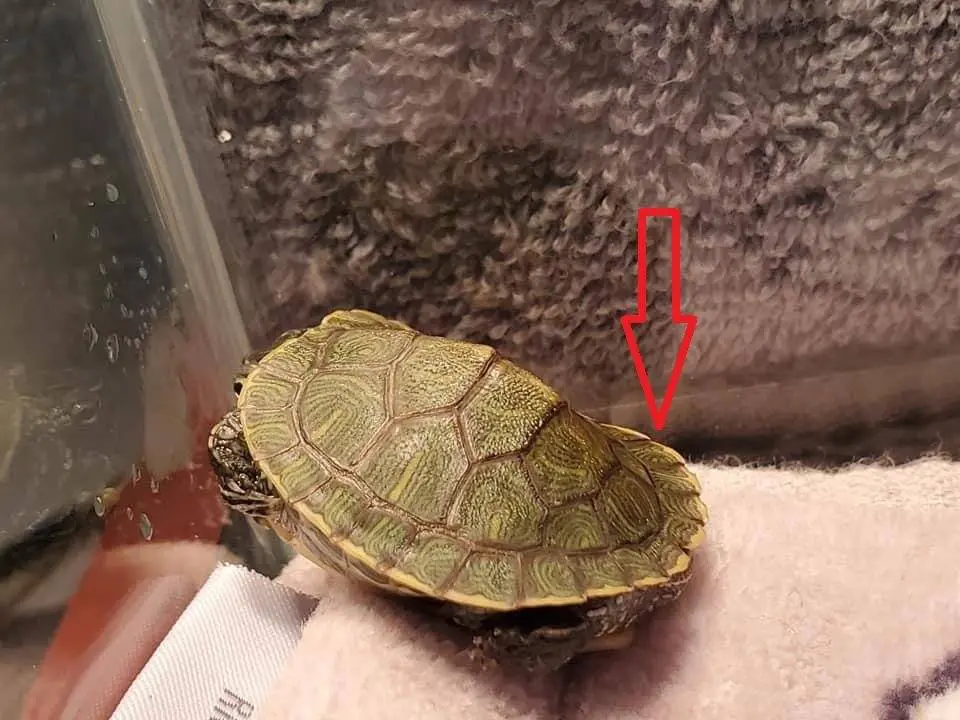Have you recently purchased a turtle or your existing pet is showing signs that its shell is curling in an upward direction? Chances are you’re worried there is something seriously wrong.
The good news is that turle shell curling up is often a sign of poor husbandry and diet.
Here is a list of reasons why your turtle’s shell is curling up and what you can do to rectify it.
Poor Quality Lighting or No Lighting
Yes, the UV light and the heat lamps you are using do give off some light, but nowhere near enough. You should be providing daylight to your turtle for 12 hours a day, working on a 12 on and 12 off cycle, mimicking their natural day night cycle.
The best way to do this is to purchase a digital timer switch, which will automatically turn the lights on and off, even when you are not at home.
Never use a colored light, not even at night. This negatively impacts your pet’s health; their eyes are exceptionally sensitive to color.

Incorrect Temperatures
When you have an aquatic turtle, such as a red-eared slider, you have to take their water, air, and basking temperatures into consideration.
Ideal temperatures are determined by the type of turtle you own. Incorrect temperatures can result in the shell curving in an upward direction.
Ideal temperatures for a red-eared slider are as follows:
- Water temperature: 74ºF to 78ºF
- Daytime air temperature: 75ºF and 80ºF
- Basking temperature: 90ºF to 95ºF
In order to maintain optimum water temperature, you need to ensure you have a powerful heater based on how much water is in the tank. The more watts the heater has, the more heat it will produce.
A general guideline is:
|
Tank Size | Heater Wattage |
|---|---|
|
20 gallon | 75 watt |
|
40 gallon | 150 watt |
| 65 gallon |
250 watt |
| 75 gallon |
300 watt |
Using an aquatic thermometer in the water can help you monitor temperatures accurately, while a digital thermometer with waterproof probe can be ideal for accurate monitoring of air temperatures and basking temperatures.
Incorrect Diet
Some breeders tend to feed a very high protein diet to turtles in order to get them to grow faster, which results in the shell curving upwards. Even new pet owners can be overfeeding without realizing it, as turtles tend to always be hungry.
Baby and juvenile turtles should be fed a protein-rich diet once daily with some greens to encourage them to start eating them. Don’t worry if they ignore them for now.
As your turtle becomes an adult, their diet must change to more plant-based foods with some protein now and then. Babies should be fed daily with adults being fed every second to third day.
Commercial pellets you can buy at the reptile shop or online are convenient and nutritious.
Even though they offer an excellent source of vitamins and minerals, you want to give your turtle a variety of foods, ensuring that they get the range of nutrients they need in a variety of forms.
Vitamins and minerals are often absorbed better when eaten in their natural form. A variety will also be more stimulating for your pet.
Live foods provide your pet with an opportunity to hunt naturally as they would in the wild. Pellets should only make up 25% of their diet.
Protein items include crickets, earthworms, bloodworms, shrimp, krill and aquatic snails, while leafy greens can include mustard greens, collard greens, dandelion greens, and kale.
Add some aquatic plants into the mix, including water lettuce and duckweed. Vegetables can include carrots, squash, and green beans.
Poor CA/P Foods
CA/P foods is a difficult ratio to fully understand. Basically, it is the ratio of calcium compared to the ratio of phosphorus in your pet’s diet. CA/P ratio of one means an equal amount of calcium and phosphorous.
If your pet isn’t getting the right ratio of calcium and phosphorus, its shell may curl.
Feeding a variety of foods is not only stimulating for your turtle but provides them with the vitamins and minerals they need. While your turtle needs a wide range of minerals and vitamins, the three most important are:
- Calcium – needed for bone, shell, and muscular function
- Phosphorous – needed for bones and shell
- Vitamin D3 – created with UV light, helps the body absorb calcium that your pet digests.
In addition to ensuring your pet has adequate UV light and a varied diet, it is also recommended to provide supplements a few times a week, such as a good quality calcium supplement, which can be sprinkled on their food or used to dust live food before feeding.
Conclusion
The good news is that when you notice your turtle’s shell curling up, you can quickly make the necessary changes to ensure you provide your turtle with the best habitat and diet, ensuring they get the vitamins and minerals they need.
What is truly fascinating about turtles is that their shells are made up of living material, which means that their shells will regrow and fix themselves over time, once you have made the necessary adjustments.
Of course, prevention is always better than cure. Ensure you provide optimum lighting, temperatures, and diet to keep your turtle happy and healthy.